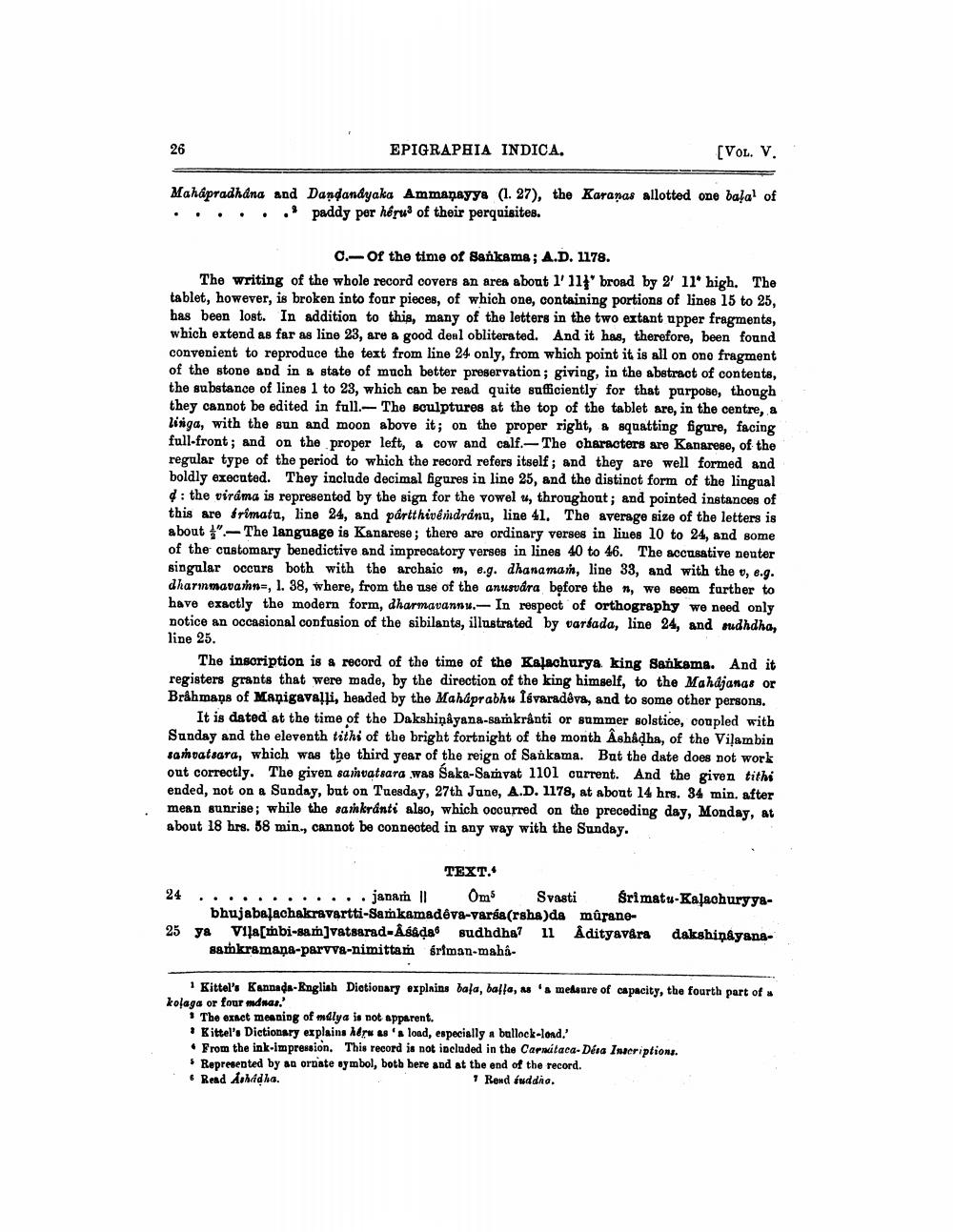________________
EPIGRAPHIA INDICA.
[Vol. V.
Mahápradhana and Dandandyaka Ammanayya (1. 27), the Karanas allotted one balal of . . . . . .'paddy per herud of their perquisites.
0.-Of the time of Sankams; A.D. 1178. The writing of the whole record covers an area about l'11' broad by 2' 11' high. The tablet, however, is broken into four pieces, of which one, containing portions of lines 15 to 25, has been lost. In addition to this, many of the letters in the two extant upper fragments, which extend as far as line 23, are a good deal obliterated. And it has, therefore, been found convenient to reproduce the text from line 24 only, from which point it is all on one fragment of the stone and in a state of much better preservation; giving, in the abstract of contents, the substance of lines 1 to 23, which can be read quite sufficiently for that purpose, though they cannot be edited in full. The sculptures at the top of the tablet are, in the centre, a lisga, with the sun and moon above it; on the proper right, & squatting figure, facing full-front; and on the proper left, a cow and calf.-The characters are Kanarese, of the regular type of the period to which the record refers itself; and they are well formed and boldly executed. They include decimal figures in line 25, and the distinct form of the lingual
: the viráma is represented by the sign for the vowel , throughout; and pointed instances of this are trimatu, line 24, and pártthivendranu, line 41. The average size of the letters is about "-The language is Kanarese; there are ordinary verses in lives 10 to 24, and some of the customary benedictive and imprecatory verses in lines 40 to 46. The accusative penter singular occurs both with the archaic m, e.g. dhanaman, line 33, and with the o, e.g. dharimavannu, 1. 38, where, from the use of the anusvára before the n, we seem farther to have exactly the modern form, dharmavannu.- In respect of orthography we need only notice an occasional confusion of the sibilants, illustrated by varsada, line 24, and mudhdha, line 25.
The inscription is & record of the time of the Kalachurya king Sauksme. And it registers grants that were made, by the direction of the king himself, to the Mahajanas or Brahmans of Mapigavalli, headed by the Maháprabhu Isvaradêve, and to some other persons.
It is dated at the time of the Dakshiņåyana-samkranti or summer solstice, coupled with Sunday and the eleventh tiths of the bright fortnight of the month Âshadha, of the Viļambin samvatsara, which was the third year of the reign of Sankama. But the date does not work out correctly. The given samvatsara .was Saka-Samvat 1101 current. And the given tithi ended, not on a Sunday, but on Tuesday, 27th June, A.D. 1178, at about 14 hrs. 34 min. after mean sunrise; while the sankranti also, which occurred on the preceding day, Monday, at about 18 hrs. 58 min., cannot be connected in any way with the Sunday.
TEXT.
24 ............janar 11 Om Svasti S rimatu-Kalachuryyl
bhujabalachakravartti-Samkamadêva-varga(rsha)da mûrane25 ya Vila[mbi-samvatsarad-Asada sudhdha7 11 Adityavára dakshinayang
samkramaņa-parvvs-nimittam sriman-maha
Kittel's Kannada-English Dictionary explains bala, balta, n'a mesure of capacity, the fourth part of kolaga or four mdnas.
The exact meaning of milya is not apparent. • Kittel's Dictionary explains aéru s load, especially a bullock-lond.' • From the ink-impression. This record is not included in the Caritaca-Désa Isacriptions . Represented by sa ornate symbol, both bere and at the end of the record. . Read Sohádka.
Rend buddio.




